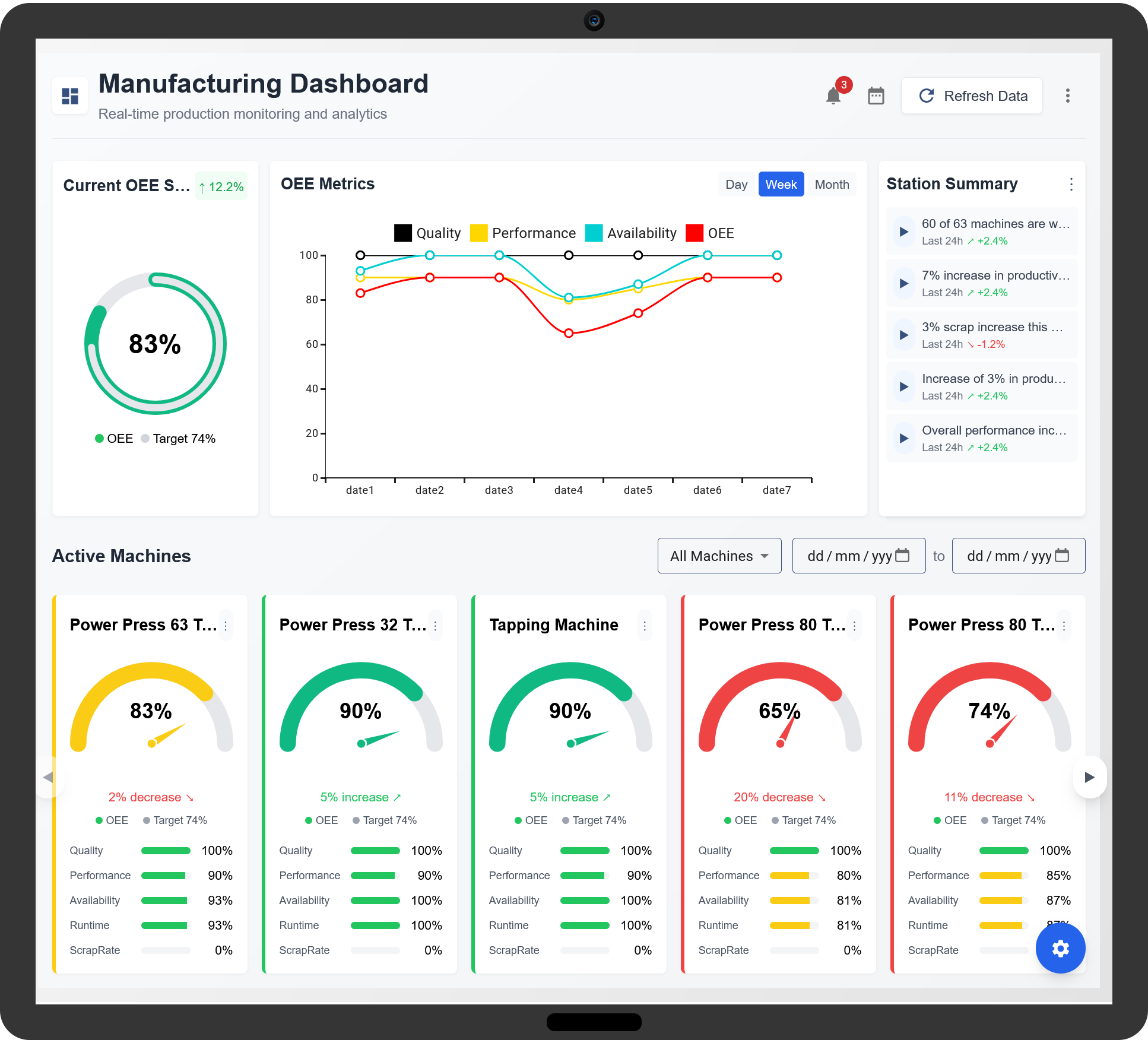Overall Equipment Effectiveness (OEE) is a critical performance metric in aerospace manufacturing, helping companies optimize productivity, reduce waste, and enhance operational efficiency. Given the industry's precision requirements and stringent quality standards, tracking OEE ensures that manufacturing processes remain efficient and compliant.

1. Key Components of OEE in Aerospace Manufacturing
- Availability: Measures equipment uptime versus planned production time, minimizing unexpected downtime.
- Performance: Evaluates whether machines operate at optimal speeds without slow cycles or micro-stoppages.
- Quality: Assesses the number of defect-free components produced, ensuring high standards.
2. How to Improve OEE in Aerospace Manufacturing
Step 1: Implement Real-Time Monitoring
Use sensors and tracking systems to collect real-time data on machine performance, availability, and production quality.
Step 2: Analyze Downtime and Bottlenecks
Identify recurring issues that cause machine stoppages and develop strategies to reduce downtime.
Step 3: Optimize Production Processes
Streamline workflows by eliminating unnecessary steps, enhancing equipment maintenance schedules, and automating manual processes.
Step 4: Enhance Quality Control Measures
Implement stringent quality checks and advanced inspection methods to minimize defects and ensure compliance.
Step 5: Train Personnel and Foster Continuous Improvement
Educate employees on best practices, encourage proactive problem-solving, and regularly update processes based on OEE data insights.
3. Benefits of Implementing OEE in Aerospace Manufacturing
- Increased Production Efficiency: Maximizes machine utilization and reduces idle time.
- Reduced Defect Rates: Ensures high-quality output with fewer rejected components.
- Lower Operational Costs: Reduces material waste and energy consumption.
- Enhanced Compliance: Maintains adherence to strict aerospace industry regulations.
- Improved Predictive Maintenance: Uses data-driven insights to prevent unexpected equipment failures.
4. Future of OEE in Aerospace Manufacturing
With advancements in AI, automation, and IoT technologies, OEE in aerospace manufacturing will continue to evolve. Predictive analytics, smart maintenance, and real-time performance tracking will further enhance productivity, ensuring manufacturers stay competitive in a demanding industry.
By optimizing OEE, aerospace manufacturers can improve efficiency, reduce costs, and maintain high-quality production standards, leading to better overall operational performance.
OEE in Aerospace Manufacturing
What is OEE in aerospace manufacturing?
OEE (Overall Equipment Effectiveness) in aerospace manufacturing is a performance metric that measures the efficiency of production processes by evaluating availability, performance, and quality.
Why is OEE important in aerospace manufacturing?
OEE is critical in aerospace manufacturing as it helps minimize downtime, improve productivity, and ensure high-quality production standards.
How is OEE calculated in aerospace production?
OEE is calculated using the formula: Availability × Performance × Quality. These factors assess machine uptime, operational speed, and defect rates.
What are the key challenges in improving OEE for aerospace?
Challenges include strict regulatory requirements, complex machining processes, high-precision manufacturing, and minimizing downtime.
How does OEE help in reducing production delays?
By tracking equipment performance and downtime, OEE enables manufacturers to address inefficiencies and streamline production schedules.
Can OEE software integrate with aerospace manufacturing systems?
Yes, OEE software can integrate with ERP, MES, and CNC systems to provide real-time performance monitoring and data analysis.
How does OEE improve machine performance in aerospace factories?
OEE identifies bottlenecks, tracks machine efficiency, and highlights areas where adjustments can improve overall performance.
What role does OEE play in quality control for aerospace parts?
OEE ensures high-quality standards by tracking defect rates, identifying sources of errors, and helping to maintain compliance.
How does OEE support predictive maintenance in aerospace manufacturing?
OEE tracks machine health and usage patterns, allowing for predictive maintenance that prevents unexpected failures and downtime.
Can OEE help optimize production schedules in aerospace?
Yes, OEE helps plan production schedules by providing real-time insights into machine availability and efficiency.
What are the common causes of downtime in aerospace manufacturing?
Common causes include machine breakdowns, tooling issues, material shortages, and unexpected maintenance requirements.
How does OEE impact cost savings in aerospace production?
OEE helps reduce waste, optimize machine usage, and minimize downtime, leading to significant cost savings.
What are the best practices for improving OEE in aerospace?
Best practices include real-time monitoring, predictive maintenance, workforce training, and process automation.
How can OEE help track compliance in aerospace manufacturing?
OEE software helps maintain compliance by tracking production accuracy, defect rates, and adherence to regulatory standards.
Is OEE applicable to both small and large aerospace manufacturers?
Yes, OEE principles can be applied to both small and large aerospace manufacturers to improve efficiency and production quality.